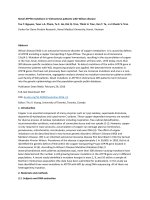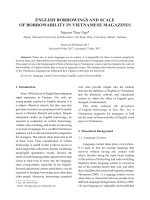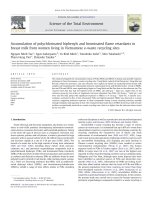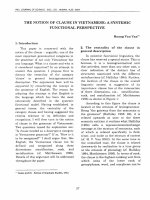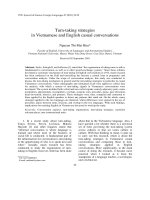Detecting familial defective apolipoprotein B-100 R3500Q in Vietnamese patients by PCR-sequencing
Bạn đang xem bản rút gọn của tài liệu. Xem và tải ngay bản đầy đủ của tài liệu tại đây (547.29 KB, 8 trang )
Journal of Science Ho Chi Minh City Open University – VOL. 1 (17) 2016 – April/2016
43
DETECTING FAMILIAL DEFECTIVE APOLIPOPROTEIN B-100
R3500Q IN VIETNAMESE PATIENTS BY PCR-SEQUENCING
Bui Van Cong1, Nguyen Thi Nga2, Pham Nguyen Oanh Vu3, Truong Kim Phuong4,*
1
Univerity of Science, Vietnam National University Ho Chi Minh City, Vietnam.
2,3,4
Ho Chi Minh City Open University, Vietnam.
*Email:
(Received: 06 /02/2016; Revised: 02 /03/2016; Accepted: 29/03/2016)
ABSTRACT
Familial defective apolipoprotein B-100 (FDB) is an autosomal codominant disorder
associated with hypercholesterolemia, caused by mutations in and around codon 3500 of the
Apolipoprotein (Apo) B gene, which encodes Apo B-100. The first mutation occurred in Arginine
codons to be described, and the most characterized, is caused by a G→A transition at nucleotide
10,708 and results in the substitution of Arginine by Glutamine at codon 3500 (ApoB R3500Q).
In this study, we have identified 27 R3500Q mutations in known FDB patients using PCRSequencing method. As the result, most of the patients carried heterozygous mutation R3500Q.
PCR-Sequencing method that we have applied in this study proved consistent and so easily
identified mutations correctly.
Keywords: Apoliprotein B-100; familial defective; ApoB R3500Q.
1. Introduction
Familial defective apolipoprotein B-100
(FDB) is an autosomal codominant disorder
associated
with
hypercholesterolemia
(Innerarity et al, 1990; Myant, 1993;
Tybjærg-Hansen, Humphries, 1992), caused
by mutations in and around codon 3500 of the
Apolipoprotein (Apo) B gene, which encodes
Apo B-100. This is the main protein of lowdensity lipoprotein (LDL) and is the ligand
through which LDL binds to its receptor in
the process of receptor-mediated endocytosis
(Brown, Goldstein, 1986).
The mutations all occur in Arginine
codons and result in an Apo B-100 molecule
that exhibits defective binding to the LDL
receptor, leading to impaired uptake of LDL
into
the
cell
and
consequently,
hypercholesterolemia. The first to be
described, and the most characterized, is
caused by a G→A transition at nucleotide
10,708 and results in the substitution of
Arginine by Glutamine at codon 3500 (ApoB
R3500Q) (Table 1 and references therein).
The other two, both recent discoveries, are
each caused by a C→T transition, one at
nucleotide 10,800 and the other at nucleotide
10,707. These result, respectively, in the
substitution of Arginine by Cysteine at codon
3531 (ApoB R3531C) (Table 1 and references
therein) and Arginine by Tryptophan at codon
3500 (ApoB R3500W) (Table 1 and
references therein). We selected total of 21
referent studies in database with period lasted
until 2015 concerning in FDB and found out
that ApoB gene point mutations related to
hypercholesterolemia
with
12
major
categories, namely: A3426V, A3527A,
E3405Q, L3350L, L3517L, R3500Q,
R3500W, R3527Q, R3531C, T3540T,
44
Detecting familial defective apolipoprotein B-100 R3500Q in Vietnamese...
T3552T, R50W (Futema et al, 2012; Choong
et al, 1997; Fisher et al, 1999; Dedoussis et
al, 2004; Friedl et al, 1991; García-García et
al, 2001; Heath et al, 2001; Henderson et al,
1997; Horvath et al, 2001; Pullinger et al,
1995; Real et al, 2003; Tybjaerg-Hansen et
al, 1998; Wang et al, 2005; Tai et al, 1998;
Tai et al, 2001; Real et al, 2003; Futema et
al, 2013; Marduel et al, 2010; Rabès et al,
2000; Thomas et al, 2013; Thiart et al, 2000),
of which, only rare mutation R50W
positioned at exon 3, all remained mutations
positioned at exon 26. In detail, R3500Q
mutation was announced at the most,
accounting for 34.4% (Futema et al, 2012;
Choong et al, 1997; Fisher et al, 1999;
Dedoussis et al, 2004; Friedl et al, 1991;
García-García et al, 2001; Heath et al, 2001;
Henderson et al, 1997; Horvath et al, 2001;
Pullinger et al, 1995; Real et al, 2003;
Tybjaerg-Hansen et al, 1998; Wang et al,
2005; Tai et al, 1998; Tai et al, 2001; Real et
al, 2003; Futema et al, 2013; Marduel et al,
2010; Rabès et al, 2000; Thomas et al, 2013;
Thiart et al, 2000). The frequency of R3500Q
was range from 0.02% to 57.14% (Futema et
al, 2012; Choong et al, 1997; Fisher et al,
1999; Dedoussis et al, 2004; Friedl et al,
1991; García-García et al, 2001; Heath et al,
2001; Henderson et al, 1997; Horvath et al,
2001; Pullinger et al, 1995; Real et al, 2003;
Tybjaerg-Hansen et al, 1998; Wang et al,
2005; Tai et al, 1998; Tai et al, 2001; Real et
al, 2003; Futema et al, 2013; Marduel et al,
2010; Rabès et al, 2000; Thomas et al, 2013;
Thiart et al, 2000). The detection of FDB was
conducted from various sources such as
whole blood, fibroblast, peripheral blood
leukocyte, buccal, saliva, …, ect, in which,
the predominant kind of sample was whole
blood. For method detection, several specific
methods, such as PCR-Sequencing, PCRSSCP, PCR-RFLP, AS-PCR, etc…, were
applied in detection FDB (Futema et al, 2012;
Choong et al, 1997; Fisher et al, 1999;
Dedoussis et al, 2004; Friedl et al, 1991;
García-García et al, 2001; Heath et al, 2001;
Henderson et al, 1997; Horvath et al, 2001;
Pullinger et al, 1995; Real et al, 2003;
Tybjaerg-Hansen et al, 1998; Wang et al,
2005; Tai et al, 1998; Tai et al, 2001; Real et
al, 2003; Futema et al, 2013; Marduel et al,
2010; Rabès et al, 2000; Thomas et al, 2013;
Thiart et al, 2000). Among them, PCRSequencing was the most common method
for detection of FDB.
Table 1. Categorize ApoB gene mutations from published studies
Name
Publication [n (%)]
∑ = 32
References
A3426V
1 (3,1%)
Futema et al, 2012
A3527A
1 (3,1%)
Choong et al, 1997
E3405Q
1 (3,1%)
Fisher et al, 1999
L3350L
1 (3,1%)
Fisher et al, 1999
L3517L
1 (3,1%)
Choong et al, 1997
11 (34,4%)
Fisher et al, 1999; Dedoussis et al, 2004; Friedl et
al, 1991; García-García et al, 2001; Heath et al,
2001; Henderson et al, 1997; Horvath et al, 2001;
Pullinger et al, 1995; Real et al, 2003; TybjaergHansen et al, 1998 ; Wang et al, 2005
R3500Q
Journal of Science Ho Chi Minh City Open University – VOL. 1 (17) 2016 – April/2016
45
Name
Publication [n (%)]
∑ = 32
References
R3500W
4 (12,5%)
Choong et al, 1997; Fisher et al, 1999 ; Tai et al,
1998 ; Tai et al, 2001
R3527Q
4 (12,5%)
Futema et al, 2012; Real et al, 2003; Futema et al,
2013; Marduel et al, 2010
R3531C
5 (15,6%)
Heath et al, 2001; Henderson et al, 1997;
Pullinger et al, 1995; Tybjaerg-Hansen et al,
1998; Rabès et al, 2000
R50W
1 (3,1%)
Thomas et al, 2013
T3540T
1 (3,1%)
Thiart et al, 2000
T3552T
1 (3,1%)
Thiart et al, 2000
We have presented the most significant
results of the data mining. Through this step,
obviously toward screening for familial
defective apolipoprotein or for familial
hypercholesterolemia,
in
general,
for
Vietnamese patients, the first approach is to
focus survey are some hot-spots, such as
ApoB gene R3500Q. Therefore, the aim at the
present study was to analyze the presence of
the most common caused FDB, R3500Q
mutation, in Vietnamese patients by using
PCR-sequencing method.
2. Materials and methods
Primer designed
ApoB gene was collected from Genbank
(NCBI) by accession number NC_000002.11.
Subsequently, primers for PCR-Sequencing
were designed by Primer3 version 0.4.0
( Physical
characteristics of primers were analyzed by
OligoAnalyzer
3.1
(Integrated
DNA
Technologies, />Annhyb ( />and BLAST (NCBI)
(blast.ncbi.nlm.nih.gov/Blast.cgi). SNPCheck3
was used to check SNPs of primer sequences.
Samples collection, DNA extraction
32 blood samples were collected from
unrelated hyperlipidemic patients, attending
the lipid clinic of Xuyen A Hospital and Thu
Duc Hospital, Vietnam. These patients had
cholesterol concentrations >5.2 mmol/L
(range: 5.33–17.46 mmol/L) without tendon
xanthomas. The procedures followed were in
accordance with the current revision of the
Helsinki Declaration of 1975.
DNA was extracted from clinical sample
by means of an enzyme digestion using 700 μl
lysis buffer (NaCl 5M, Tris-HCl 1M, EDTA
0.5M, SDS 10% and Proteinase K 1 mg/ml).
The samples were incubated at 56oC
overnight. Then, DNA obtained and purified
by Phenol/Chloroform extraction and ethanol
precipitation. The quality and purity of DNA
extraction was measured by the proportion of
A260/A280. Then, the DNA solution was stored
at EDTA 0.5M, -20oC for further used.
Detection of R3500Q
R3500Q detection was carried out by
PCR-Sequencing method. The forward
(ABOP-F) and reverse primer (ABOP-R)
sequences were
5’-GACCACAAGCTTAGCTTGG-3’,
5’-GGGTGGCTTTGCTTGTATG-3’,
respectively. The amplification was done in a
total volume of 15 μl, containing 10 ng DNA
template. PCR reaction was subjected to initial
at 95oC for 5 minutes, followed by 35 cycles at
95oC for 30 seconds, 54oC for 30 seconds,
72oC for 30 seconds, and finally 72oC for 10
46
Detecting familial defective apolipoprotein B-100 R3500Q in Vietnamese...
minutes. PCR products were directly loaded
onto a 2.0% agarose gel, stained with Ethidium
bromide, and directly visualized under UV
illumination. Then, PCR products were sent to
Nam Khoa Biotect for sequencing.
3. Results and discussion
Primer designed
Primer3.0 program was used to design the
primer to amplify a partial of ApoB regions.
According to table 2, primers’ several
physical characteristics such as length, %GC,
melting temperature (Tm), ΔG were almost
corresponded to standard parameters of
primer designed, such as 50-65% GC, melting
temperature (Tm) rising between 50 and
65°C, dimerization capability (ΔG) is in the
range of -9 Kcal/mole – +9 Kcal/mole, except
the value of self-dimer structure forming by
APOB-F (-10.23 Kcal/mole). The targetspecificity of chosen primer was accessed by
BLAST, as the results, APOB-F and APOB-R
were specific to ApoB gene region containing
ApoB R3500Q (G/A) with the same E-value =
0.66, ident = 100%.
Table 2. The physical characteristic of primers
Primer
Sequence
Length
(bp)
GC
(%)
Tm
(oC)
(1)
(2)
APOB-F
GACCACAAGC
TTAGCTTGG
19
52,6
53.6
-3.79
-10.23
APOB-R
GGGTGGCTTT
GCTTGTATG
19
52,6
54.3
0.1
(3)
Product
(bp)
-5.09
334
-3.14
Note: (1) Free energy for hair-spin structure forming (Kcal/mole); (2) Free energy for self-dimer
structure forming (Kcal/mole); (3) Free energy for heterodimer structure forming (Kcal/mole).
SNPCheck3 was used to check SNP on the
primer sequences. As the result, we did not
detect any SNP on two designed primers (Data
not shown), so the pairing between each primer
on target gene sequences should be specific.
PCR and Sequence analysis of the
ApoB gene R3500Q
334 bp
Total samples were enrolled in PCR for
detection of R3500Q. The APOB forward and
reverse primers yielded a PCR product of 334
bp as shown in table 2. As the results, the
PCR
products
were
observed
by
electrophoresis in correctly sizes and easily
identified (Fig.1).
400 bp
300 bp
Figure 1. Agarose gel electrophoresis of some representative samples.
Consequently, PCR products was
sequenced in order to detect R3500Q
mutation. At first, the signal of peaks in PCR
product sequencing was very good for
reading nucleotide (Data not shown). Then,
32 double sequences were used to search for
Journal of Science Ho Chi Minh City Open University – VOL. 1 (17) 2016 – April/2016
the similarity by Blast. According to Blast
results, all sequences were similar to ApoB
gene sequences within Total score = 334,
Ident = 100% and E-value < 2e-33 (Data not
shown).
At position c10708, Genbank nucleotide
47
sequence (NC00002.11) is G, while its
location in the patient TD10 appeared two
peaks, corresponding to two alleles, one allele
sequence is G and another is A. So, TD10
patient carried R3500Q mutation (G→A
transition), heterozygous (Fig. 2).
Figure 2. DNA sequencing result of affected ApoB region at exon 26
showing heterozygous mutation R3500Q.
Meanwhile, at the patient’s location
c10708, patient XA22 appeared only one peak
corresponding to a sequence allele A. Thus
patient XA22 carried R3500Q mutation,
homozygous (Fig. 3).
Figure 3. DNA sequencing result of affected ApoB region at exon
26 showing homozygous mutation R3500Q.
Off total 32 samples enrolled in PCRSequencing for detection of R3500Q, 27
patients were shown contain a G→A transition
at nucleotide 10,708 and results in the
substitution of Arginine by Glutamine at
codon 3500 (ApoB R3500Q); i.e., five of them
were heterozygous for ApoB R3500Q, whereas
the remained were homozygous (Data not
shown). All of the signal of peaks in PCR
product sequencing was very good for reading
nucleotides, especially at the transition
positions (Data not shown). This result was
surprising though the sample size was very
small, but R3500Q mutation appeared too
high, compared to the recorded worldwide,
ranging from 0.02% to 57.14%. One possible
reason is that the completely subjects were
initially chosen as definitive FH patients. In
addition, sequencing with a short PCR product
as 334 bp can achieve high R3500Q mutation
and therefore display better diagnostic
performance.
ApoB
R3500Q
was
demonstrated as changing ApoB protein
structure, completely broke the link between
LDLR receptor with carrier cholesterol
(LDLC) and therefore this is the cause of
48
Detecting familial defective apolipoprotein B-100 R3500Q in Vietnamese...
familial defective apolipoprotein (FDB),
consequently, accumulate of cholesterol in the
blood which lead to cardiovascular disease
risk (Hevonoja et al, 2000). The Familial
defective apolipoprotein B-100 as well as
familial hypercholesterolemia is increasing
and more diversity in Viernamese population.
It means that the risk of serious diseases
related to high cholesterol such as heart stroke
or other cardiovascular diseases tends to
increasingly. Thus, this study will be expanded
not only on large samples but also consider to
other related genes such as LDLR or PSK9.
4. Conclusion
In summary, we have identified 27
R3500Q mutations in known FDB patients
using PCR-Sequencing method. In which,
most of patients carried heterozygous
mutation R3500Q. PCR-Sequencing method
that we have applied in this study proved
consistent and so easily identified mutations
correctly. With the sequencing cost dropping
out, this method will be easy in clinical
application for screening of risk FDB, on
Vietnamese population in near future.
Acknowledgments
This work was supported by HoChiMinh
city Open University Fund. The assistance of
the Xuyen A Hospital and Thu Duc Hospital,
Vietnam, are also gratefully acknowledged.
REFERENCES
Brown, M. S., Goldstein, J. L. (1986). A receptor-mediated pathway for cholesterol homeostasis,
Science, 232(4746), 34 - 47.
Choong, M. L., Koay, E. S., Khoo, K. L., Khaw, M. C., Sethi, S. K. (1997). Denaturing gradientgel electrophoresis screening of familial defective apolipoprotein B-100 in a mixed Asian
cohort: two cases of arginine3500tryptophan mutation associated with a unique
haplotype, Clin Chem., 43(6 Pt 1), 916 - 923.
Dedoussis, G. V., Genschel, J., Bochow, B., Pitsavos, C., Skoumas, J., Prassa, M.,
Lkhagvasuren, S., Toutouzas, P., Vogt, A., Kassner, U., Thomas, H. P., Schmidt, H.
(2004). Molecular characterization of familial hypercholesterolemia in German and Greek
patients, Hum Mutat., 23(3), 285 - 286.
Fisher, E., Scharnagl, H., Hoffmann, M. M., Kusterer, K., Wittmann, D., Wieland, H., Gross,
W., März, W. (1999). Mutations in the apolipoprotein (apo) B-100 receptor-binding
region: detection of apo B-100 (Arg3500Trp) associated with two new haplotypes and
evidence that apo B-100 (Glu3405Gln) diminishes receptor-mediated uptake of LDL,
Clin Chem., 45(7), 1026 - 1038.
Friedl, W., Ludwig, E. H., Balestra, M. E., Arnold, K. S., Paulweber, B., Sandhofer, F.,
McCarthy, B. J., Innerarity, T. L. (1991). Apolipoprotein B gene mutations in Austrian
subjects with heart disease and their kindred, Arterioscler Thromb., 11(2), 371 - 378.
Futema, M., Plagnol, V., Whittall, R. A., Neil, H. A. (2012). Use of targeted exome sequencing
as a diagnostic tool for Familial Hypercholesterolaemia, J Med Genet., 49(10), 644 - 649.
Futema, M., Whittall, R. A., Kiley, A., Steel, L. K., Cooper, J. A., Badmus, E., Leigh, S. E.,
Karpe, F., Neil, H. A., Simon Broome Register Group, Humphries, S. E. (2013). Analysis
of the frequency and spectrum of mutations recognised to cause familial
hypercholesterolaemia in routine clinical practice in a UK specialist hospital lipid clinic,
Atherosclerosis, 229(1), 161 - 168.
Journal of Science Ho Chi Minh City Open University – VOL. 1 (17) 2016 – April/2016
49
García-García, A. B., Real, J. T., Puig, O., Cebolla, E., Marín-García, P., Martínez Ferrandis, J.
I., García-Sogo, M., Civera, M., Ascaso, J. F., Carmena, R., Armengod, M. E., Chaves, F.
J. (2001). Molecular genetics of familial hypercholesterolemia in Spain: Ten novel LDLR
mutations and population analysis, Hum Mutat., 18(5), 458 - 459.
Heath, K. E., Humphries, S. E., Middleton-Price, H., Boxer, M. (2001). A molecular genetic
service for diagnosing individuals with familial hypercholesterolaemia (FH) in the United
Kingdom, Eur J Hum Genet., 9(4), 244 - 252.
Henderson, B. G., Wenham, P. R., Ashby, J. P., Blundell, G. (1997). Detecting familial defective
apolipoprotein B-100: three molecular scanning methods compared, Clin Chem., 43(9),
1630 - 1634.
Hevonoja, T., Pentikäinen, M. O., Hyvönen, M. T., Kovanen, P. T., Ala-Korpela, M. (2000).
Structure of low density lipoprotein (LDL) particles: basis for understanding molecular
changes in modified LDL, Biochim Biophys Acta., 1488(3), 189 - 210.
Horvath, A., Savov, A., Kirov, S., Karshelova, E., Paskaleva, I., Goudev, A., Ganev, V. (2001).
High frequency of the ApoB-100 R3500Q mutation in Bulgarian hypercholesterolaemic
subjects, J Med Genet., 38(8), 536 - 540.
Innerarity, T. L., Mahley, R. W., Weisgraber, K. H., Bersot, T. P., Krauss, R. M., Vega, G. L.
(1990) Familial defective apolipoprotein B-100: a mutation of apolipoprotein B that causes
hypercholesterolaemia, J Lipid Res., 31(8), 1337 - 1349.
Marduel, M., Carrié, A., Sassolas, A., Devillers, M., Carreau, V., Di Filippo, M., Erlich, D.,
Abifadel, M., Marques-Pinheiro, A., Munnich, A., Junien, C.; French ADH Research
Network, Boileau, C., Varret, M., Rabès, J. P. (2010). Molecular spectrum of autosomal
dominant hypercholesterolemia in France, Hum Mutat., 31(11), E1811 – E1824.
Myant, N. B. (1993). Familial defective apolipoprotein B-100: including some comparisons with
familial hypercholesterolaemia, Atherosclerosis., 104(1-2), 1 - 18.
Pullinger, C. R., Hennessy, L. K., Chatterton, J. E., Liu, W., Love, J. A., Mendel, C. M., Frost, P.
H., Malloy, M. J., Schumaker, V. N., Kane, J. P. (1995). Familial ligand-defective
apolipoprotein B. Identification of a new mutation that decreases LDL receptor binding
affinity, J Clin Invest., 95(3), 1225 - 1234.
Rabès, J. P., Varret, M., Devillers, M., Aegerter, P., Villéger, L., Krempf, M., Junien, C.,
Boileau, C. (2000). R3531C mutation in the apolipoprotein B gene is not sufficient to
cause hypercholesterolemia, Arterioscler Thromb Vasc Biol., 20(10), E76 - E82.
Real, J. T., Chaves, F. J., Ejarque, I., García-García, A. B., Valldecabres, C., Ascaso, J. F.,
Armengod, M. E., Carmena, R. (2003). Influence of LDL receptor gene mutations and the
R3500Q mutation of the apoB gene on lipoprotein phenotype of familial
hypercholesterolemic patients from a South European population, Eur J Hum Genet.,
11(12), 959 - 965.
Real, J. T., Chaves, F. J., Ejarque, I., García-García, A. B., Valldecabres, C., Ascaso, J. F.,
Armengod, M. E., Carmena, R. (2003). Influence of LDL receptor gene mutations and the
50
Detecting familial defective apolipoprotein B-100 R3500Q in Vietnamese...
R3500Q mutation of the apoB gene on lipoprotein phenotype of familial
hypercholesterolemic patients from a South European population, Eur J Hum Genet.,
11(12), 959 - 965.
Tai, D. Y., Pan, J. P., Lee-Chen, G. J. (1998). Identification and haplotype analysis of
apolipoprotein B-100 Arg3500-->Trp mutation in hyperlipidemic Chinese, Clin Chem.,
44(8 Pt 1), 1659 - 1665.
Tai, E. S., Koay, E. S., Chan, E., Seng, T. J., Loh, L. M., Sethi, S. K., Tan, C. E. (2001).
Compound heterozygous familial hypercholesterolemia and familial defective
apolipoprotein B-100 produce exaggerated hypercholesterolemia, Clin Chem., 47(3),
438 - 443.
Thiart, R., Scholtz, C. L., Vergotine, J., Hoogendijk, C. F., de Villiers, J. N., Nissen, H.,
Brusgaard, K., Gaffney, D., Hoffs, M. S., Vermaak, W. J., Kotze, M. J. (2000).
Predominance of a 6 bp deletion in exon 2 of the LDL receptor gene in Africans with
familial hypercholesterolaemia, J Med Genet., 37(7), 514 - 519.
Thomas, E. R., Atanur, S. S., Norsworthy, P. J., Encheva, V., Snijders, A. P., Game, L.,
Vandrovcova, J., Siddiq, A., Seed, M., Soutar, A. K., Aitman, T. J. 1. (2013). Identification
and biochemical analysis of a novel APOB mutation that causes autosomal dominant
hypercholesterolemia, Mol Genet Genomic Med., 1(3), 155 - 161.
Tybjærg-Hansen, A., Humphries, S. E. (1992). Familial defective apolipoprotein B-100: a single
mutation that causes hypercholesterolaemia and premature coronary artery disease,
Atherosclerosis., 96(2-3), 91 - 107.
Tybjaerg-Hansen, A., Steffensen, R., Meinertz, H., Schnohr, P., Nordestgaard, B. G. (1998).
Association of mutations in the apolipoprotein B gene with hypercholesterolemia and the
risk of ischemic heart disease, N Engl J Med., 338(22), 1577 - 1584.
Wang, J., Ban, M. R., Hegele, R. A. (2005). Multiplex ligation-dependent probe amplification of
LDLR enhances molecular diagnosis of familial hypercholesterolemia, J Lipid Res., 46(2),
366 - 372.
